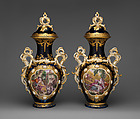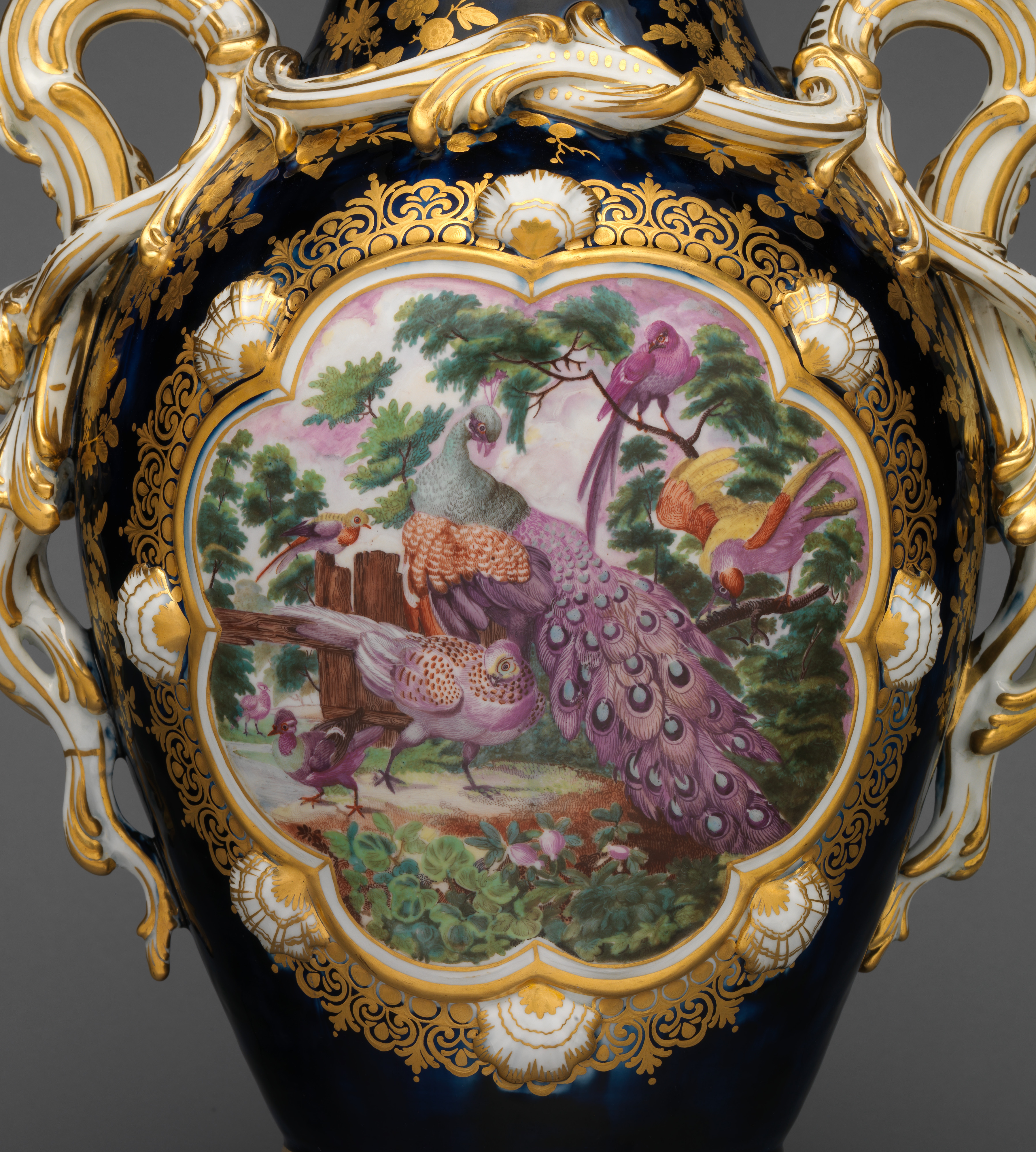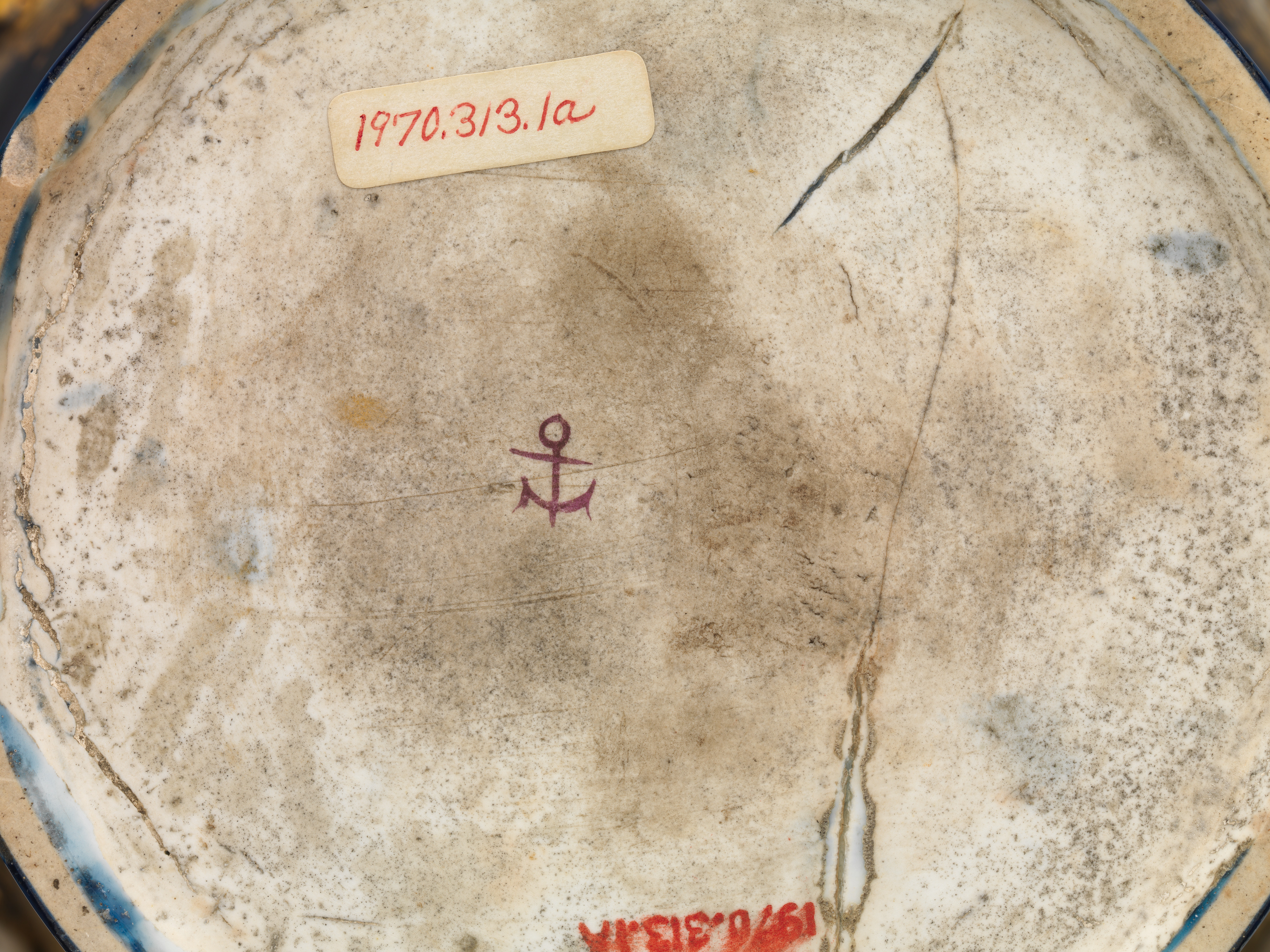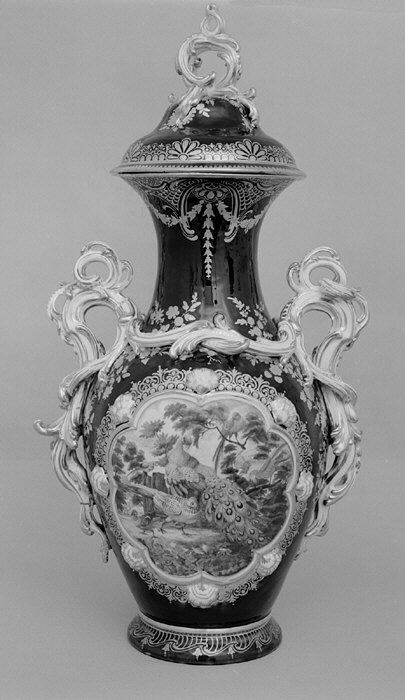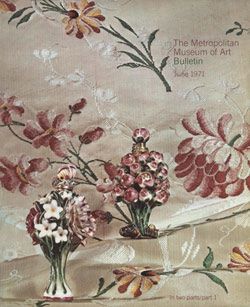Vase (one of a pair)
Manufactory Chelsea Porcelain Manufactory British
After a print by René Gaillard French
After a painting by François Boucher French
No works better express the rich style characteristic of the porcelain produced at Chelsea during the Gold Anchor period (1758–69) than these two elaborately decorated vases.[1] Their ambitious enamel painting, extensive gilding, sculptural embellishments, and large scale reflect the taste associated with Gold Anchor Chelsea at its most lavish, and also indicate the strong influence of Sèvres porcelain from the late 1750s and 1760s. The products of the French royal manufactory from these years are distinguished by their vivid ground colors, richly applied gilding, and masterly enamel decoration, as well as by the use of novel shapes. Because the Sèvres factory became the taste setter in Europe following the decline of the Meissen factory during the Seven Years’ War (1756–63), numerous porcelain factories, including Chelsea, looked to Sèvres for inspiration.
The deep-blue ground color of these vases closely copies a similar blue used at Sèvres that was known as bleu lapis (lapis blue),[2] and it seems to have been perceived in England as emblematic of high-style French porcelain in the 1770s. The abundant use of gilding on the vases also reflects the influence of Sèvres, where gilt decoration was employed as a major decorative element rather than being completely subordinate to the enamel painting. On these vases, the gilding frames the reserves, accentuates the feet and rims, lightens the visual effect of the dark-blue ground, and contributes significantly to their rich visual impact. The most direct borrowing from Sèvres is seen in the use of compositions by the French artist François Boucher (1703–1770) to decorate the reserves on the primary sides of the vases. Prints made after works by Boucher, which were widely circulated in the mid-eighteenth century, were among the sources most commonly used by the painters at Sèvres, and Boucher’s compositions were adapted for biscuit sculpture as well.[3] The painters at Chelsea used prints after Boucher’s L’Agréable Leçon (The enjoyable lesson) and Les Amants Surpris (The surprised lovers) for the fronts of the vases.[4] Although Boucher had painted L’Agréable Leçon in 1748, it was not engraved until 1758.[5] After the engraving became available, the composition was used frequently for painted decoration at Sèvres, but most known examples depicting L’Agréable Leçon date from 1765 or later. Thus, the appearance of this subject on Chelsea porcelain is surprisingly early and reflects the factory’s desire to be in the forefront of fashion.[6]
While the prints after Boucher were closely copied, the palette employed at Chelsea is very different from the one used at Sèvres, and the muted, slightly muddy colors create a very different effect than those produced by similar reserves painted at the French factory. This distinction also applies to the secondary reserves of the two vases that are decorated with birds in a landscape. The same muted palette dominated by browns and purples is used, and the dense compositions of multiple birds among extensive vegetation are far removed from the style of bird painting practiced at Sèvres. The small amount of sky depicted on these vases is filled with purple clouds, which, in combination with the birds and foliage, results in compositions with almost no white porcelain visible, in contrast to the airy, abbreviated landscapes that the Sèvres birds typically inhabit (entry 65).
Perhaps the most striking feature of the Museum’s two vases is the handles and the finials of the lids. The handles are composed of elongated leafy scrolls arranged in curving, sinuous lines that overlap and intertwine. Their design embodies the Rococo style in its embrace of exaggerated curves, asymmetry, and the use of abstracted natural motifs, and the finials exhibit the same qualities. The handles are more sculptural in form and larger in scale than would normally be found on a Sèvres vase of this period, and it has often been suggested that the handles on these and similar Chelsea Gold Anchor period vases are deliberately evoking the gilt-bronze mounts that were frequently applied to porcelain vases in France in the mid-eighteenth century. The mid-eighteenth century witnessed the height of the fashion for embellishing with gilt bronze, and the mounts of this period were typically Rococo in design and considerably more elaborate than the porcelain handles applied to vases. Even though it is plausible that Gold Anchor period handles such as these were a response to gilt-bronze mounts, it is curious that these handles and those on other vases of the period are not entirely gilded but rather simply highlighted in gold.
This last observation underscores one of the curious contradictions of these two vases and others produced in the same taste at Chelsea. While the design sources and influences are entirely French, the interpretation, execution, and resulting aesthetic effect are completely English. No single component of the design of these vases could be mistaken for French, despite the overwhelmingly French taste that informs them. Interestingly, this pair of vases, along with a closely related pair, was in the collection of William Ward (1817–1885), 1st Earl of Dudley, by the third quarter of the nineteenth century.[7] The related vases, known as the Foundling Vase and the Chesterfield Vase, due to their early owners, were acquired by the earl in 1869 and 1868 respectively,[8] but it is not known when the Museum’s vases entered the Dudley collection. All four vases were offered at auction in 1886 but failed to sell at their reserve prices (the price below which they would not be sold), which were unrealistically high. The Earl of Dudley was one of the most important and avid collectors of eighteenth-century Sèvres porcelain in the years between 1870 and 1885, spending extraordinary sums to acquire some of the most significant examples of porcelain from the ancien régime.[9] It can be assumed that the earl knew that he was acquiring Chelsea Gold Anchor vases in the French taste rather than actual pieces of Sèvres porcelain, especially as three of the four vases bear the Chelsea factory mark clearly on the base, and it is notable that he deemed them worthy to be displayed among the porcelains that ultimately inspired them.
Footnotes
(For key to shortened references see bibliography in Munger, European Porcelain in the Metropolitan Museum of Art. NY: The Metropolitan Museum of Art, 2018)
1 A very similar pair of vases is now in the Victoria and Albert Museum, London. One of these, known as the Foundling Vase, provides a touchstone for dating the four vases, as it is documented as having been donated in 1763 to the Foundling Hospital in London. It is now reunited with its mate, known as the Chesterfield Vase, from which it was separated early in their histories. An additional two similar vases are known to have survived. See Hilary Young in Baker and Richardson 1997, pp. 312–14, nos. 143, 144.
2 The bleu lapis ground color was replaced at Sèvres by a similar blue known as bleu nouveau in 1763, approxi-mately at the time the Museum’s vases were made. 3 See, for example, Linda H. Roth in Roth and Le Corbeiller 2000, pp. 340–48, nos. 170–72.
4 René Gaillard (French, ca. 1719–1790) etched and engraved both L’Agréable Leçon and Les Amants Surpris.
5 As the composition had been used at Sèvres as early as 1752, it is probable either that the factory had a copy of the painting or that Boucher had provided a drawing of it to the factory; Savill 1988, vol. 1, p. 228.
6 One of Chelsea’s best-known figure groups also derives from Boucher’s composition. Entitled The Music Lesson, it was first produced in about 1765; for an example, see MMA 64.101.519.
7 Mallet 1965.
8 Young in Baker and Richardson 1997, pp. 312–14, nos. 143, 144.
9 Dauterman 1970, p. 186.
Due to rights restrictions, this image cannot be enlarged, viewed at full screen, or downloaded.
This artwork is meant to be viewed from right to left. Scroll left to view more.
